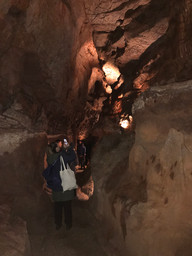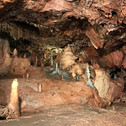Discovering the Ice Age Fossil's of Devon and Dorset coast
- Wayne Munday
- Mar 11, 2022
- 5 min read
Updated: 5 days ago
The Ice Age history of Devon and Dorset reveals a fascinating prehistoric world where megafauna roamed and early humans thrived. From the Honiton Hippo and Sherford Woolly Mammoth to the famous Kents Cavern near Torbay, this region offers a unique glimpse into the Pleistocene epoch. Fossil discoveries include cave bears, sabre-toothed cats, mammoths, woolly rhinoceros, and traces of early Homo erectus, Neanderthals, and modern humans dating back 500,000 years. The landscape was shaped by recurring glacial and interglacial periods, altering climates, sea levels, and ecosystems. Today, Devon and Dorset remain vital for archaeology, palaeontology, and UNESCO-recognised geoparks like Kents Cavern, where visitors can explore caves, fossil sites, and the story of Ice Age Europe firsthand.

My interest in the ice age of Devon and Dorset started recently with a story I heard about the Honiton Hippo. I don't mean the endurance event billed as a "Tough Multi-terrain race with Roughly 7 miles of Mud, Sweat and Tears" held in September in Honiton.

But instead the story about the remains of Hippopotamus "cheek teeth" found in 1965 during the excavation of the new A30 Honiton Bypass. These fossils are among the youngest found along the Jurassic Coast at 135,000 years of age. It was established that Honiton at the time was the home to large deer, oxen, elephant and hippopotamus and the climate would have been similar to a tropical savannah. The Honiton Hippo can be seen at the Honiton Museum.
In 2019 a young lad found a woolly mammoth tooth on the Jurassic Coast at Charmouth and this story was covered in the national press. More recently in February 2022 over 200 clusters of ice age fossil bone remains were found in a cave system uncovered by a digger during the building of a new town in Sherford near Plymouth. It is expected that the full archive of remains will be taken care of by The Box, Plymouth’s recently revamped museum.
At this point I knew Fossil Coast Drinks needed to consider the ice age as part of its new "Fossil Coast" product development and future story in a bottle. The Team started with researching the ice age in the region and visited the nearby Kents Cavern to understand the impact of the ice age along the Devon and Dorset coast.
Images of Fossil Coast's visit to Kents Cavern in March 2022. These caves were once inhabited by ice age animals and early humans. You can get married in the caves!
The megafauna of herbivores (plant eaters) and carnivores (meat eaters) or the large animals that were once were a prominent feature of the land and oceans were huge but now extinct. The cave bears would been over 1.5 meters high and 3 meters in length weighing up to 440kg. By comparison the mammoths could grow to 3 meters high at the shoulder. Interestingly, the Slavic word for “mammoth” is “mammut” that means “earth mole”. This was because the early mammoths with thick hairy coast and huge tusks were found underground in the frozen tundra of Siberia.

Over the years Devon and Dorset has uncovered several remains of “megafauna” such as the Woolly Mammonth (Mammuthus primigenius) alongside others including the woolly rhinoceros (Coelodonta antiquitatis), hyena (Crocuta crocuta), cave bears (Ursus denigeri & Ursus spelaeus), cave lion (Panthera leo), sabre-toothed cat (Homotherium latidens), horse, reindeer, mountain hare, wolf (Canis lupus) and red fox (Vulpes vulpes).
A combination of these animal fossils have also been found mixed with the earliest traces of humans dating back 500,000 years providing an incredible insight into South West during the Ice Ages.
(Image by Yena Kwon)
So when was the ice age?
We are currently living during the Quaternary a geologic unit of time that began 1.6 million years ago and still continues through to present day. The Quaternary and specifically the epoch known as the Pleistocene that ended only 11,700 years ago was characterised by several periods of glaciation or ice ages.
There was never just one ice age but a series of recurring cold and warm periods lasting many thousands of years each time. The cold periods or ice ages were characterised by colder global temperatures and glacial expansion of ice sheets many kilometres thick.
Both the warmer and colder periods impacted vast areas of continents causing dramatic changes to the climate, sea level, altered environments and changed the ecosystem for plants (flora) and animals (fauna) to survive, flourish or simply become extinct. Glaciers during each of the ice ages reshaped the landscape by picking up rocks and soil and eroding the landscape and the sheer weight depressed the Earth’s crust.
The warmer periods known as an interglacials were where the sea levels would rise as ice fields melted and both plant life and animals would flourish and environment became more hospitable.
During the Pleistocene there were three warm interglacial periods called the:
Cromerian (750,000 – 350,000 years ago)
Hoxnian (250,000 – 200,000 years ago)
Ipswichian (125,000 – 72,000 years ago)
These were interlinked with three cold ice age periods known as the:
Anglian (350,000 – 250,00 years ago)
Wolstonian (200,000 – 125,000 years ago)
Devensian (72,000 – 12,000 years ago)
The recurring nature of these cold and warm periods often makes it difficult to date the time period of the fossils remains uncovered. It often takes time for archaeologists and palaeontologists to assess if ice age fossil remains are from a similar time period or existed at different points over a longer time span. The movement of water and land masses created areas where fossil remains were deposited from different eras.
Among the the complexity of these fossil remains are the bones and artefacts of human tools from the earliest people known to be in Europe called Homo erectus followed by Homo sapien neanderthalensis (Neanderthal) and early Homo sapiens sapiens or modern human. Among the ice age record of the South West of England is the earliest traces of humans dating back 500,000 found a Kent Cavens near Torquay.
This location has an international reputation as one of Europe's most important prehistoric cave sites and is open to visitors. There are 120 UNESCO Global Geoparks in 33 countries around the world plus Kents Cavern is member of the ice age Europe network of seventeen other heritage sites. In the UK there are seven Geoparks including the English Riviera UNESCO Global Geopark covering all of Torbay and the towns of Brixham, Paignton, Torquay and Babbacombe, and the marine environment of Tor Bay.
To put everything in to context the dinosaurs and the ferocious marine reptiles of the Jurassic Coast became extinct approximately 65 million years ago. Despite this extinction event the fossil record still continued and through the subsequent years a combination of archaeological excavations, building developments and good old fashioned fossil hunting along the coastline is still uncovering fossils from the ice age.





















